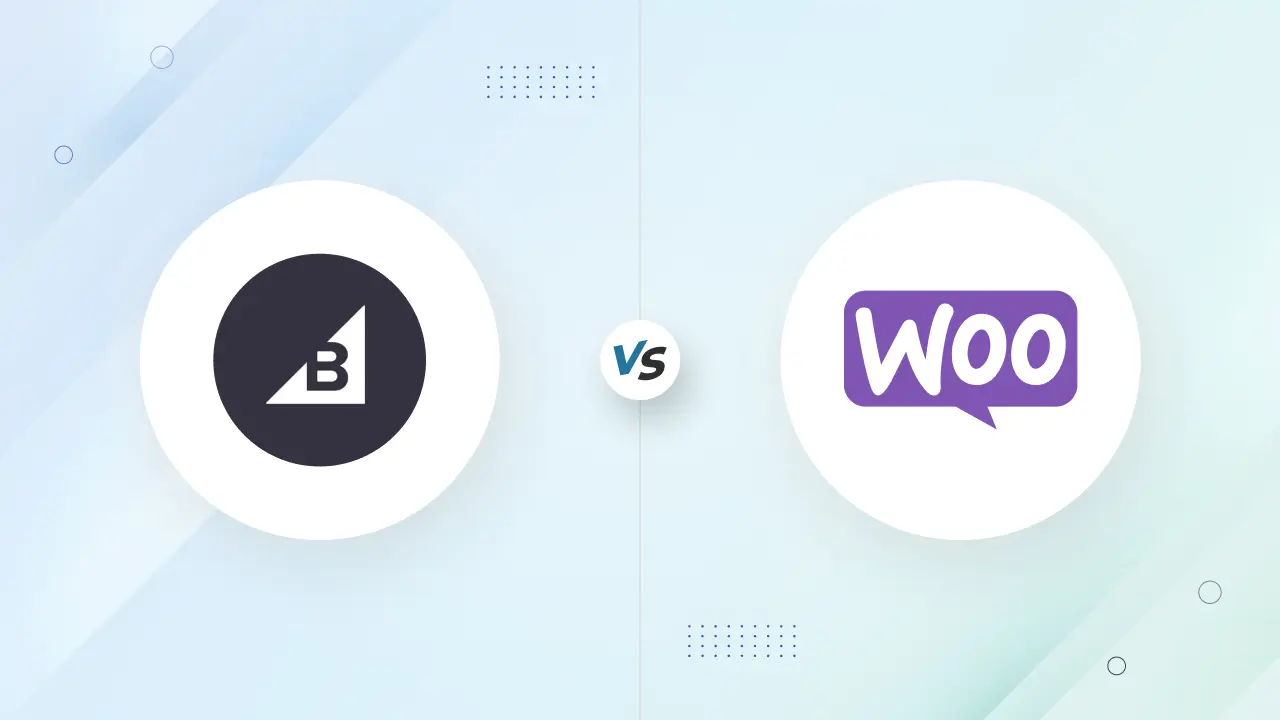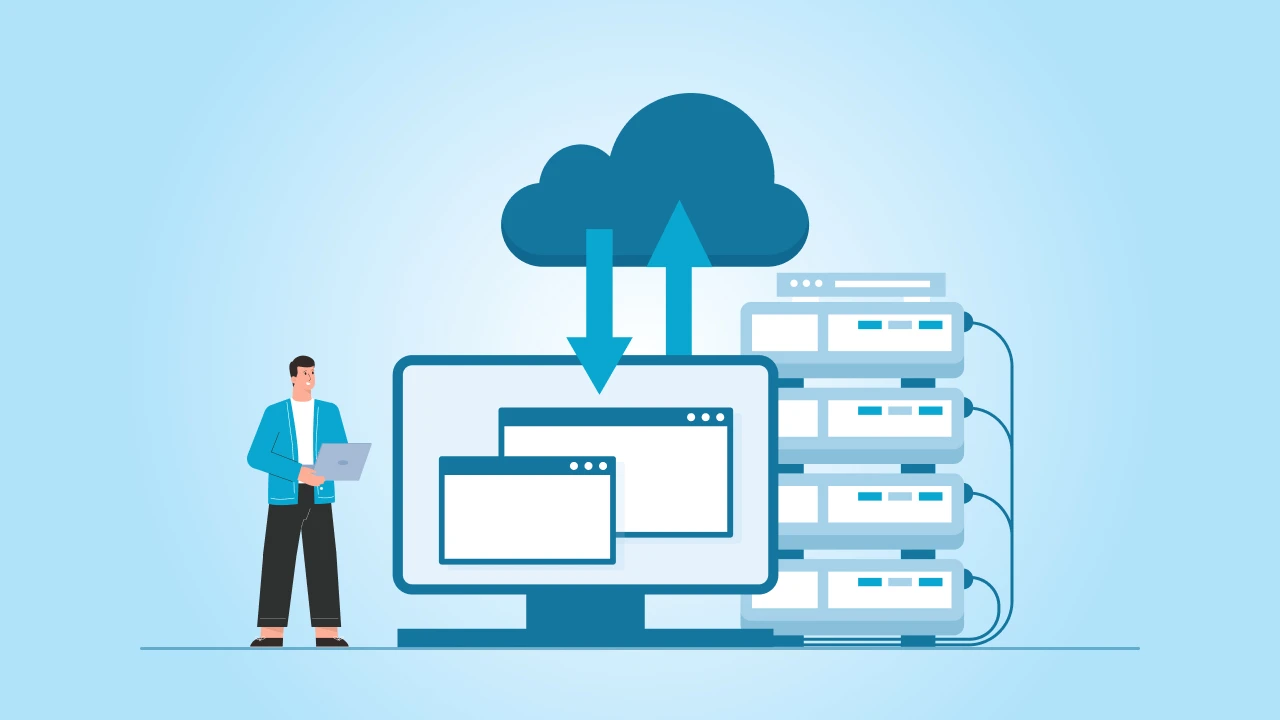Two of the most popular options for building an online store today are BigCommerce and WooCommerce—both are powerful, but they each have their own strengths.
BigCommerce is a fully hosted solution, meaning everything you need comes built-in, so you don’t have to worry about things like hosting or security updates. On the other hand, WooCommerce is a plugin for WordPress, giving you a lot of flexibility and control over how your store looks and operates.
It really comes down to your business needs—whether you are looking for something easy to set up and manage, or you want more control and customization.
In this post, we will dive into the key differences between BigCommerce and WooCommerce, helping you figure out which platform will best suit your online store.
Core Platform Characteristics
Let’s start with the basics—what makes BigCommerce and WooCommerce different in terms of setup and how they function.
BigCommerce is a fully hosted solution, meaning they take care of everything for you. From hosting to security updates, you don’t have to worry about a thing. This makes it a great choice for anyone who doesn’t want to deal with the technical side of things and just wants to focus on running their business. You sign up, pick a plan, and start building your store. It’s that simple.
On the other hand, WooCommerce is a self-hosted plugin for WordPress. This gives you more control over your site, but it also means you are responsible for finding your own hosting, setting up security, and managing updates. It’s perfect if you are looking for flexibility and want to fully customize your store, but it can be a bit more work upfront. Think of it like building your own house—there’s a lot of freedom, but you also need to manage every part of the process.
BigCommerce vs. WooCommerce (Feature Comparison)
Let’s dive into some key features that will help you compare these two platforms side by side.
Product Management and Catalog Capabilities
If you are running a store with a large inventory or products that come in different variations (like sizes or colors), BigCommerce makes it easy to organize everything. The built-in tools allow you to manage product variants and large catalogs without needing extra plugins. It’s all ready to go as soon as you set up your store.
On the flip side, WooCommerce gives you flexibility in creating custom product pages. While it’s great for tailoring your products exactly how you want, managing large inventories can be a bit trickier. For bigger catalogs, you might need to add plugins to make things run smoothly.
Payment Gateway Options and Processing
When it comes to accepting payments, BigCommerce has you covered right out of the box. It supports multiple payment gateways like PayPal, Stripe, and even Apple Pay, which means you won’t have to deal with complex setups to start accepting payments.
With WooCommerce, you get a wide range of payment gateway options too. However, the setup can be a little more hands-on. You will need to configure the gateways yourself or use third-party plugins, depending on the method you want to offer customers.
Inventory Management Tools
BigCommerce really shines in inventory management. Whether you are selling on your website, Amazon, or eBay, its built-in tools help you manage stock levels, automate reorders, and sync inventory across different sales channels. Everything’s automated, so you can focus on growing your business without worrying about stock management.
WooCommerce offers basic inventory management, which works well for small stores. But if you are scaling up or managing inventory across multiple platforms, you might want to add plugins to get more advanced features, like stock synchronization or automated reordering.
Built-in Marketing Features
Marketing is a breeze with BigCommerce, as it comes with built-in tools for abandoned cart recovery, email marketing, and running promotions. All these features are included in your plan, so you don’t have to hunt down third-party apps to get started with marketing your store.
On the WooCommerce side, marketing features are available too, but you will need plugins to unlock them. For example, you can add email marketing tools or create special discounts, but you will need to set up the plugins yourself. The upside is that you get to choose exactly which tools suit your needs.
SEO Capabilities
BigCommerce takes care of SEO right out of the gate. You can easily customize your URLs, add meta descriptions, and generate sitemaps automatically—making it easier to get your site noticed by search engines.
WooCommerce benefits from WordPress’s SEO-friendly structure, and with the help of plugins like Yoast, you can have full control over your SEO settings. While you will need to set it up yourself, this gives you the flexibility to optimize your store however you see fit.
Mobile Commerce Support
When it comes to mobile commerce, BigCommerce is fully responsive, meaning your store will look great on smartphones and tablets, with no extra work required. Your customers will have a seamless experience whether they are shopping from a desktop or their mobile device.
WooCommerce is also mobile-friendly, as most themes are designed to be responsive. However, depending on the theme you pick, you might need to make a few tweaks to get the perfect mobile experience for your customers.
Third-party Integrations and App Ecosystems
If you are looking to expand your store’s reach, BigCommerce offers a robust app marketplace with integrations for major platforms like Amazon, eBay, and Google Shopping. These are built right into the platform, so connecting your store to these channels is straightforward.
With WooCommerce, you have tons of flexibility with plugins and third-party integrations. Whether you want to add new sales channels or enhance your store’s functionality, WooCommerce has a plugin for just about everything. The catch is that you will need to install and configure these integrations yourself.
Ready to Build or Customize Your Store? We’ve Got You Covered!
Pricing Structure
When it comes to pricing, both BigCommerce and WooCommerce offer different models, and understanding these costs will help you choose the best option for your business.
BigCommerce Pricing Tiers and Included Features
BigCommerce operates on a subscription-based pricing model, with several plans to choose from: Standard, Plus, Pro, and Enterprise. Each plan has a set monthly fee, and the features increase as you move up the tiers. For example:
- Standard: Includes essential features like product management, mobile-friendly themes, and a built-in blog.
- Plus: Adds features like abandoned cart recovery, customer groups, and advanced shipping options.
- Pro: Includes everything from the Plus plan, plus more robust reporting, faceted search, and up to 3 staff accounts.
- Enterprise: A customizable plan designed for large businesses with custom pricing and advanced features tailored to your needs.
While the higher-tier plans offer more functionality, keep in mind that BigCommerce also charges for apps and integrations that you might need to enhance your store. And while the Pro and Enterprise plans don’t have transaction fees, the Standard and Plus plans do, so you will need to factor those into your calculations as well.
WooCommerce Core Costs (Hosting, Domain, SSL)
WooCommerce itself is free, but there are some essential costs that come with running a WordPress-based store. You will need to pay for:
- Hosting: WooCommerce is a plugin for WordPress, so you will need a hosting provider to run your site. There are many affordable WordPress hosting options, but as your store grows, you may need to upgrade to a more powerful plan.
- Domain Registration: This is the cost of buying your website’s domain name, which is usually around $10-20 per year.
- SSL Certificate: For security and to ensure customers feel confident shopping on your site, you will need an SSL certificate. Some hosting providers include this in their plans, but if not, it can cost about $50-150 per year.
While WooCommerce doesn’t have a subscription fee like BigCommerce, you will need to budget for these ongoing costs to keep your store running.
Additional Costs (Themes, Plugins, Extensions)
- BigCommerce: While BigCommerce’s higher-tier plans include many advanced features, you might need to pay for additional apps and integrations that suit your specific needs. Some apps are free, but more specialized tools can come with extra fees. It’s important to keep in mind that your costs could grow as you add more functionality to your store.
- WooCommerce: While the plugin itself is free, you might want to purchase premium themes, plugins, or extensions to enhance your store’s functionality. For example, adding features like advanced SEO tools, payment gateways, or shipping options could cost anywhere from a few dollars to hundreds, depending on the plugins you choose. So, while the upfront cost is low, you may find yourself paying more over time as you scale your business.
Transaction Fees Comparison
- BigCommerce: One thing to keep in mind with BigCommerce is the transaction fees on lower-tier plans. The Standard and Plus plans come with a percentage fee on sales, which can add up as your business grows. However, Pro and Enterprise plans don’t have transaction fees, so if you are processing a lot of orders, it might be worth moving up to one of these higher plans.
- WooCommerce: WooCommerce itself doesn’t charge transaction fees, but if you are using third-party payment gateways (like PayPal or Stripe), they may charge a small percentage per transaction. These fees are generally lower than BigCommerce’s, especially if you are on the lower-tier plans, but they can still add up if your sales volume is high.
Long-Term Cost Analysis
- BigCommerce: One of the benefits of BigCommerce is its predictable pricing. Once you choose your plan, you will know exactly how much you are paying each month. However, as your store grows and you move to higher plans with more features, the monthly cost can increase. Plus, if you need extra apps or integrations, those can add extra costs over time.
- WooCommerce: The initial costs for WooCommerce Maintenance may be lower, especially since the plugin itself is free. However, you will need to factor in the ongoing costs for hosting, domain, SSL, and plugins. These costs can add up, and while they might start low, they can grow as your store gets more complex. Plus, managing WooCommerce requires more maintenance and updates, which could require developer time or additional resources.
In simple terms, BigCommerce offers a more straightforward pricing structure with predictable costs, but WooCommerce might be the more affordable option initially—though it requires more work to set up and maintain. Both platforms come with their own set of costs, so it’s important to consider your budget and long-term growth when deciding which one works best for you.
Scalability Factors
As your business grows, you will need an e-commerce platform that can handle increased traffic, larger inventories, and the challenges of managing more customers. Let’s compare how BigCommerce and WooCommerce stack up when it comes to scalability.
Handling High Traffic and Large Inventories
When it comes to handling high traffic, BigCommerce is built for it. It’s optimized to manage large volumes of visitors and can easily support large inventories without the need for extra resources. As your store grows, BigCommerce scales smoothly, ensuring performance remains strong even during peak shopping times.
With WooCommerce, scalability depends heavily on your hosting and how well you optimize your site. While WooCommerce can handle high traffic, it often requires extra customization or fine-tuning to run efficiently on large-scale operations. You might need to adjust your hosting plan or add extra caching and performance enhancements as your store grows.
Server and Hosting Considerations
BigCommerce takes care of hosting for you. All plans come with managed hosting, meaning you don’t have to worry about finding your own server or worrying about uptime. Resources are allocated based on your plan, so as you upgrade, you get more power to handle higher traffic.
For WooCommerce, since it’s a self-hosted solution, you will need to choose a hosting provider yourself. The good news is that you have a lot of options, but the scalability depends on the provider you choose. If you are planning on running a large store, you may need to upgrade to VPS or even dedicated servers to ensure your site can handle the increased load.
Performance Optimization Options
BigCommerce has built-in tools that help optimize your store’s performance. This means better speed, security, and overall reliability. You don’t have to worry about configuring caching, databases, or other technical aspects—BigCommerce has it covered.
With WooCommerce, performance can certainly be optimized, but it requires a bit more technical know-how. You will need to manage things like caching, use Content Delivery Networks (CDNs) for faster loading times, and optimize your database to ensure smooth performance as your store scales. If you are not tech-savvy, you may need to hire someone to handle these optimizations for you.
International Selling Capabilities
BigCommerce is great if you want to go global. It offers built-in features like multi-currency support, language options, and international shipping settings. This makes it easy to run a store that caters to customers around the world, without having to worry about configuring multiple systems.
While WooCommerce can definitely support international selling, it requires a bit more setup. You will need to configure payment gateways that accept multiple currencies, set up shipping options for different regions, and ensure your store is multi-lingual if needed. WooCommerce is flexible, but you will have to handle the configuration yourself.
Multi-store Management
Managing multiple stores? BigCommerce makes it easy with built-in multi-store management. You can run several stores from one account, which is ideal if you are expanding into different regions or selling different product lines. Everything is managed in one place, saving you time and effort.
WooCommerce doesn’t have built-in multi-store functionality. If you want to run multiple stores, you will either need to set up separate installations of WooCommerce for each store or use advanced configuration tools. While it’s doable, it can be more complex compared to BigCommerce’s straightforward approach.
Security and Maintenance
Now, security and maintenance are important elements for keeping your store running smoothly and protecting your customers’ data. Let’s see how BigCommerce and WooCommerce handle these important aspects.
Built-in Security Features
BigCommerce makes security a no-brainer. SSL certificates are included in every plan, so your site is encrypted and secure for visitors. On top of that, it’s PCI compliant right out of the box, ensuring that your store meets strict payment security standards. Regular security updates are also handled for you, so you don’t need to lift a finger to keep your store safe.
With WooCommerce, security depends on a few factors. You will need to choose a secure hosting provider, install the right WordPress security plugins, and keep everything (like themes and plugins) updated. While it offers a lot of flexibility, staying on top of security is your responsibility, which can require more effort.
Updates and Patch Management
One of the perks of BigCommerce is that updates are automatic. The platform takes care of all software updates and security patches, ensuring your store stays up-to-date without you having to manage it.
For WooCommerce, updates are a bit more hands-on. Since it runs on WordPress, you will need to manage updates for the core platform, your theme, and any plugins you use. While updates are fairly straightforward, forgetting to apply them can leave your store vulnerable to security issues.
Backup Solutions
BigCommerce includes automatic backups as part of its service. If anything goes wrong, your data is safely stored and can be restored easily, giving you peace of mind.
With WooCommerce, backups aren’t built in. You will need to rely on third-party plugins or hosting solutions to set up regular backups. While there are plenty of great tools available, it’s something you will need to manage and monitor yourself to ensure your data is protected.
PCI Compliance
BigCommerce is PCI DSS compliant on all plans. This means the platform meets industry standards for processing, storing, and transmitting credit card information securely, which is a huge plus if you are handling online payments.
For WooCommerce, PCI compliance is on you. You will need to set up and maintain compliance, which can involve configuring your payment gateways, securing your hosting environment, and ensuring your store meets all necessary requirements. It’s doable but requires extra work and technical know-how.
Customization and Design
Your store’s design is the first thing customers notice, so having the right customization options is key. Whether you want a simple setup or a unique, branded look, both BigCommerce and WooCommerce offer tools to help you achieve your vision. Let’s explore how they compare.
Theme Availability and Quality
BigCommerce comes with a selection of professionally designed themes that are modern and mobile-friendly. They are easy to customize, so you can tweak colors, fonts, and layouts to fit your brand without needing to touch any code. While the options are somewhat limited compared to WooCommerce, they are polished and ready to use right out of the box.
WooCommerce, on the other hand, offers an almost endless variety of themes—both free and premium. Whether you need something minimalist or a more complex layout, there’s likely a theme for it. Plus, because WooCommerce is built on WordPress, you have access to thousands of themes designed for WordPress websites, giving you even more choices. If you are willing to invest in a premium theme or hire a designer, you can create a truly unique look.
Custom Development Requirements
If you are looking for advanced customization, BigCommerce offers some flexibility through apps and APIs, but there are limits. It’s designed to work “out of the box,” so while you can tweak the look and feel, it doesn’t offer the deep customization that WooCommerce does.
WooCommerce is a dream for developers. You can modify almost anything, from layouts to functionality, but this level of customization usually requires coding knowledge or help from a developer. For businesses with specific design needs or a creative vision, WooCommerce offers unparalleled flexibility, though it may come at the cost of more time and technical effort.
Learning Curve for Customization
BigCommerce makes customization simple. Its built-in tools are intuitive, so you don’t need to be a tech wizard to make your store look great. You can adjust most design elements with just a few clicks, making it a good option if you are new to eCommerce.
With WooCommerce, there’s a steeper learning curve. While basic tweaks are easy to make, unlocking the platform’s full potential often requires technical expertise. If you want to take advantage of its flexibility, you might need to spend time learning WordPress or hire a WordPress developer who knows the ropes.
Design Flexibility
BigCommerce strikes a balance between ease of use and design flexibility. It’s ideal if you want a good-looking store without diving too deep into technical customization. However, it has its limits; creating something truly unique might not be possible without advanced apps or external help.
WooCommerce shines in design flexibility. Because it’s open-source and built on WordPress, you can customize virtually every aspect of your store. From intricate layouts to one-of-a-kind features, WooCommerce lets you bring almost any idea to life. The trade-off is that this level of freedom often requires more work and technical know-how.
Technical Requirements
Every online store comes with some behind-the-scenes technical work. Let’s look at what BigCommerce and WooCommerce demand when it comes to hosting, expertise, development, and maintenance.
Hosting Needs
BigCommerce takes care of hosting for you. As a fully hosted platform, you don’t need to worry about finding a hosting provider, managing servers, or ensuring your store stays online. It’s all part of the package, making it super convenient—especially if you are not tech-savvy.
WooCommerce, being a self-hosted solution, requires you to arrange your own hosting. The good news is that there are plenty of options to choose from, ranging from affordable shared hosting to high-performance dedicated servers. The hosting plan you choose will depend on your store’s size, traffic, and future growth plans.
Technical Expertise Required
BigCommerce is beginner-friendly, making it ideal if you are just starting out or prefer a hands-off approach. You don’t need much technical expertise to set up or run your store. The platform is designed to be intuitive, so you can focus on growing your business without worrying about technical details.
WooCommerce, on the other hand, demands a bit more technical know-how. Setting up a WooCommerce store involves configuring WordPress, choosing a hosting provider, and possibly tweaking plugins and themes. While basic tasks are manageable, advanced customization or troubleshooting might require some technical skills.
Development Resources Needed
BigCommerce requires minimal development resources. Most of the functionality is built-in, and customization options are easy to use without coding. If you want to extend your store’s capabilities, there are apps and integrations available that don’t require developer involvement.
WooCommerce offers incredible flexibility, but this often comes with a need for Woocomerce development expertise. If you are planning advanced customizations, building bespoke features, or integrating third-party tools, you will likely need a WooCommerce developer. For businesses with unique requirements, having access to skilled development resources is a must.
Maintenance Responsibilities
With BigCommerce, maintenance is one less thing to worry about. The platform handles regular updates, security patches, and performance improvements automatically. This “set it and forget it” approach means you can spend more time running your business and less time managing your website.
WooCommerce puts maintenance in your hands. You will need to keep WordPress, your theme, and all plugins up to date to ensure your store runs smoothly and securely. While this gives you complete control, it also means you are responsible for making sure everything is working as it should.
Support and Community
In case you are just starting out or running a busy store, having reliable support and a strong community to lean on can make a huge difference. Here’s how BigCommerce and WooCommerce handle support and what kind of resources they offer.
Official Support Channels
BigCommerce makes support simple and accessible. They offer 24/7 support through live chat, phone, and email, so you can get help whenever you need it. Whether it’s a technical issue or just a quick question about your store, their team is ready to assist.
WooCommerce doesn’t have centralized support because it’s open-source software. Instead, you will often turn to your hosting provider, the plugin or theme developer, or third-party experts for help. While this can work well, it can also mean bouncing between different sources to find the solution you need.
Community Resources
Both platforms have strong communities, but they operate a little differently. BigCommerce offers an extensive knowledge base, active forums, and customer support resources. It’s a great ecosystem for store owners who prefer official guidance combined with community input.
WooCommerce has one of the largest communities in the eCommerce space, thanks to its connection to WordPress. From tutorials and blogs to user forums, you’ll find countless resources to help you troubleshoot and improve your store. Additionally, many developers and plugin providers offer their own guides and support.
Documentation Quality
BigCommerce provides clear and comprehensive documentation for all its features. Whether you are setting up your store or exploring advanced options, their guides are easy to follow and cover just about everything you need.
WooCommerce also has extensive documentation, but the quality can vary—especially when it comes to third-party plugins or themes. While the core WooCommerce documentation is solid, you might find that some plugin developers have less polished or incomplete guides, which can be frustrating when you’re trying to solve a problem.
Developer Ecosystem
And if you are planning customizations, both platforms offer solid developer support. BigCommerce has tools like APIs and integrations to help developers build custom solutions, but the options are somewhat limited compared to WooCommerce.
WooCommerce, by contrast, is incredibly developer-friendly. There’s a huge ecosystem of developers who specialize in WooCommerce, offering custom themes, plugins, and tailored solutions for just about any need. If you have specific requirements or a big vision for your store, the WooCommerce developer community is a powerful resource.
Pros and Cons Summary
Choosing between BigCommerce and WooCommerce often comes down to your specific needs and priorities. Let’s wrap up with a quick look at the strengths, limitations, and ideal use cases for each platform.
BigCommerce Strengths and Limitations
BigCommerce is a solid all-in-one solution. It’s easy to use, scales effortlessly as your business grows, and comes packed with strong built-in features like advanced security and marketing tools. For anyone who wants a straightforward platform that takes care of the technical side, it’s a fantastic option.
However, BigCommerce isn’t without its drawbacks. Its customization options are more limited compared to WooCommerce, which may be a dealbreaker if you are looking for complete creative freedom. Additionally, the monthly subscription costs can add up, especially for higher-tier plans or as your needs grow.
WooCommerce Advantages and Disadvantages
WooCommerce excels in flexibility. It’s highly customizable, allowing you to tweak every aspect of your store to match your vision. The initial setup cost is also relatively low, and the extensive plugin ecosystem means you can add almost any feature you need.
On the downside, WooCommerce requires ongoing maintenance. Updates, backups, and security are all your responsibility, which can be time-consuming. Scalability also depends heavily on your hosting setup, so you will need to invest in good hosting if your store grows.
Best Use Cases for Each Platform
- BigCommerce is ideal for businesses that want an easy-to-manage, scalable solution with robust built-in features. If you prefer minimal technical involvement and need a reliable platform that handles the backend for you, BigCommerce is a great fit.
- WooCommerce is perfect for businesses that value flexibility and don’t mind rolling up their sleeves. If you are looking for a low-cost entry point, are comfortable with managing technical aspects, or want a platform that adapts to unique requirements, WooCommerce is the way to go.
Let’s sum it up with some final recommendations and considerations.
Final Recommendations Based on Business Size
If you are a small to medium-sized business looking for a hassle-free solution, BigCommerce is an excellent choice. It’s scalable, user-friendly, and takes care of the technical details so you can focus on growing your store.
On the other hand, WooCommerce is perfect for businesses of all sizes that want full control over customization and design. Whether you are a small boutique or a large-scale operation, WooCommerce adapts to your vision and provides unmatched flexibility.
Considerations for Different Types of Merchants
For merchants who value simplicity and robust built-in features, BigCommerce is a standout option. It’s especially well-suited for those who appreciate a reliable support system and minimal technical involvement.
Meanwhile, if you are a merchant who loves flexibility, thrives on technical challenges, or wants a platform that grows and evolves with your creativity, WooCommerce is the way to go. It’s ideal for those who prefer to take the reins and build their store on their terms.
Future Growth and Platform Longevity
If you are focused on long-term growth and scalability with minimal technical management, BigCommerce offers a sustainable path. Its managed hosting, built-in features, and seamless upgrades make it a dependable partner for your business’s journey.
For businesses planning to fully customize their store and invest in ongoing WooCommerce maintenance costs, WooCommerce provides the tools to create something truly unique. With the right resources and expertise, it’s a platform that can evolve alongside your ambitions.
Our experts at cmsMinds can guide you to the perfect solution for your eCommerce business.





